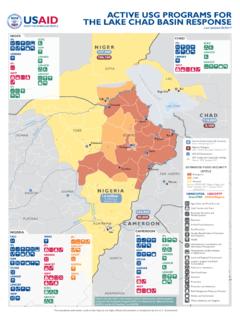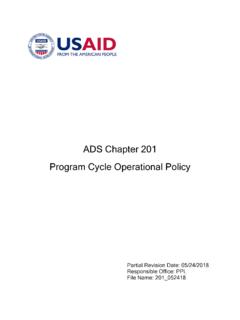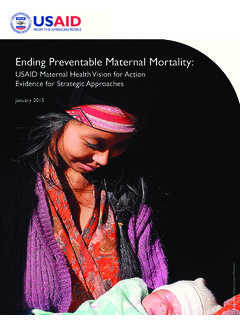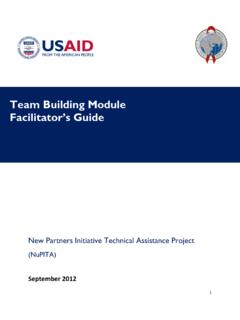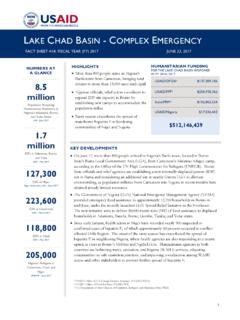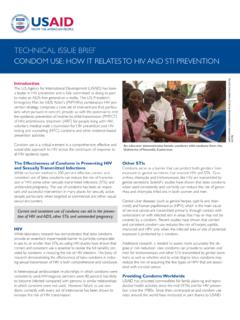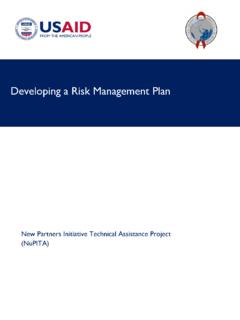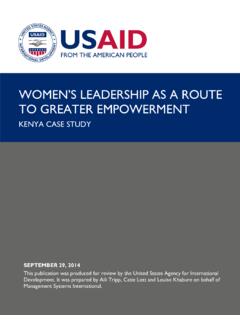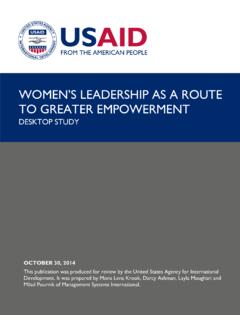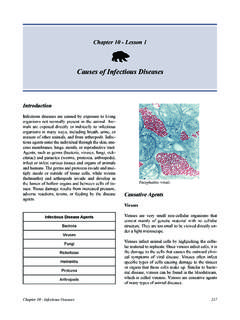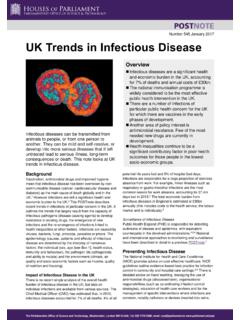Transcription of Combating Infectious Diseases: Fact Sheet
1 Combating Infectious DISEASES fact Sheet Scores of Infectious diseases threaten humankind. Both FAMILIAR ones like: malaria HIV tuberculosis neglected tropical diseasesand EMERGING viruses and bacterial infections like: severe acute respiratory syndrome (SARS) H5N1 Avian Infl uenza Middle East Respiratory Syndrome (MERS-CoV) Ebola ZikaThe global community is faced with ongoing endemic disease threats and an increased frequency of emerging outbreaks driven by surging populations, environmental change, and globalized travel. For decades, USAID has been a leader in the control and prevention of Infectious diseases.
2 Today, USAID-funded programs have achieved tremendous success in the fi ght against malaria, HIV/AIDS, Tuberculosis, neglected tropical diseases, pandemic infl uenza, and other emerging threats. Working with ministries of health, partners, and communities, USAID scales up effective, equitable, locally adapted, and evidence-based interventions to reach poor, marginalized, and vulnerable people to prevent and treat Infectious diseases. In our increasingly interconnected society, a health threat anywhere is a threat everywhere. USAID s work fi ghting Infectious diseases not only save and improve lives, but also are strategic investments in America s security and the President s Malaria Initiativ, led by USAID and implemented with CDC, hundreds of millions of people have benefi ted from protective measures and have been diagnosed and treated for malaria.
3 PMI has surpassed expectations, contributing to historic reductions in malaria deaths and illness in partner countries. For example, from 2000-2015, more than million malaria deaths were averted primarily among children under the age of fi ve living in sub-Saharan Africa. USAID has programs in 19 countries in sub-Saharan Africa and three countries in the Greater Mekong sub-region of Southeast Asia under PMI. Malaria still kills nearly a half a million people each year, with the vast majority being children under fi ve years has contributed to71% reported REDUCTION in malaria mortality among children under fi ve in sub-Saharan Africa between 2000-2015 Tuberculosis Tuberculosis (TB) is the leading Infectious disease killer globally, yet it is both preventable and curable.
4 Last year, USAID supported high-quality screening, diagnosis and treatment services for millions of people in 23 countries. More than million TB cases detected and diagnosed. More than million people provided with TB treatment. More than 70,000 people with multidrug-resistant tuberculosis (MDR-TB) started on appropriate treatment. With partner countries, USAID is working to improve care, strengthen services, and provide new diagnostics and drugs in the fi ght against TB. One example of this assistance is improving access to a game-changing test that can diagnose individuals with TB more quickly and accurately.
5 USAID is rolling out new MDR-TB drugs and regimens that save lives, as well as investing in pivotal clinical , the Global Fund, and the global community have made tremendous progress in treating tuberculosis:43 million lives saved in the last 15 years (a 47 percent decline in TB mortality) and the incidence rates are now declining globally. The USG Strategy will reach, cure, and prevent TB, reducing incidence b25% y90%success rate 13 millionin treating at leastTB patientsTreatments 560,000of at leastpeople with MDR-TBby 2020 USAID fact SHEETCOMBATING Infectious DISEASES Neglected Tropical Diseases (NTDs)USAID has supported the delivery of more than 2 billion treatments to prevent and treat the seven most prevalent NTDs to more than 935 million people across 25 countries.
6 9%8%6%67%1%11%4%12%3%4%1%1%37%21%9%5%1%T otal$15 BillionCatalyzes$26worthof NTDM edicine$11 BILLION leveragedover thelast decade2007 | | | | | | | | 201663 per persontreated(full loaded cost of NTD program)FAR $ nolonger requiringtreatmentfor longerrequiringtreatmentfor lymphaticfila LONGERREQUIRINGTREATMENT FOR BLINDINGTRACHOMABILLIONIN $ IN DRUGDONATIONS$ LONGER REQUIRING TREATMENT FOR BLINDING TRACHOMABILLIONPEOPLE29 pertreatmentMore than 1 billion people worldwide suffer unnecessarily from a group of parasitic and bacterial infections known as neglected tropical diseases (NTDs).
7 These diseases impact the poorest of communities, often living in areas without access to basic health services. NTDs cause profound suffering and disability, perpetuating the cycle of poverty and inequality. In some cases, these diseases cause blindness and physical disfi gurements that leave people unable to see, walk, and contribute to local economies. NTDs maintain a fi rm grip on the livelihoods of people, families, communities and local economies. In partnership with pharmaceutical companies, ministries of health and education, andcommunities, we work to strengthen national NTD programs, in part by increasing the reach of mass treatment campaigns to all people at risk.
8 Currently, 70 percent of USAID supported countries are on track to stop treatment for LF and trachoma by 2020.$26To date: in donated medicines for mass Every $1 treatmentinvestedcampaigns by the US totalling Government$11 BILLIONin valueAs a resultHIGHIMPACTLOWCOSTN early 200 million people no longer need treatment for lymphatic fi lariasis (LF) and nearly 85 million people no longer need treatment for blinding $1 investedby the USGovernmentLeverages$26in donatedmedicines63 perpersonHIGHIMPACTLOWCOSTL everages Emerging Pandemic ThreatsRecent estimates indicate that only one percent of microbial threats have likely been identifi ed.
9 Pandemics cause devastation to human lives and livelihoods much as do wars and fi nancial crises. USAID works tostrengthen capacity in countries to prevent, detect, andrespond to Infectious diseases in animals and people through a One Health Approach. USAID s efforts have contributed to dramatic downturns in poultry outbreaks and human infections , leading to a 62 percent reduction in the number of countries affected by identifying and responding to dangerous pathogens originating in animals before they can become signifi cant threats to human health. USAID focuses on hotspots of previous disease emergence and zones where the risks of spillover, amplifi cation and spread are greatest.
10 SARSS evere Acute Respiratory Syndrome20142012200920052003H5N1 Avian Infl uenzaMERSM iddle East Respiratory SyndromeRecent threats:ZIKAEBOLAHINIS wine FluYELLOW FEVER2016 Global Health Security Agenda (GHSA)treatmentper63 perperson29 The next pandemic could begin anywhere With more than 70% of new Infectious disease outbreaks originating in animals, USAID mainly focuses on the animal health elements of existing and emerging pathogens. This includes the prevention of health-care associated infections through appropriate use of antibiotics in both people and livestock; and preparedness and response to outbreaks at the community level.
